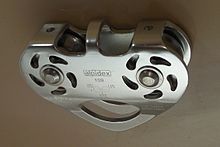Double pulley
A double rope pulley or tandem pulley is used to reduce friction losses in pulley blocks and cable cars .
construction
The housing is made of aluminum , the rollers are made of stainless steel (for steel or static ropes ) or aluminum (for static ropes), the bolts are made of stainless steel and the ends are riveted. The rollers rotate on a plain bearing or are ball-bearing. The breaking load is around 25 kN (corresponding to 2500 daN), the working load is around 10 kN (corresponding to 1000 daN). A tandem roller weighs just under 300 g.
Screw-in carabiners or self-locking twist-lock carabiners are always used for hanging .
Cable car
Static ropes up to 13 mm are used for ropeways or steel ropes up to 12 mm for permanent installations. Ropeways with static ropes are built twice for safety reasons (redundant): two carrying ropes, two pulleys. Steel ropes may only be used with double rope pulleys with steel pulleys, as the abrasion on aluminum pulleys would be too great. The permissible speed for plain bearings is around 10 m / s (36 km / h) with an efficiency of up to 71%, for high-speed rollers (speed rollers) with encapsulated high-performance ball bearings up to 20 m / s (72 km / h) with an efficiency of up to 96%. A screw carabiner is always used as a carabiner and the locking screw must be carefully closed.
For commercial ropeways in high ropes courses, there are closed pulleys with a permanently integrated self-locking carabiner and a firmly spliced tie-in loop. This means that it is not possible to get into the reel by hand or to lose the reel or the carabiner when hanging. Such rollers are usually made of stainless steel and weigh up to 500 g. Rope pulleys for mountaineers are often tested according to CE EN 12278.
Pulley
With a double pulley and a single pulley, pulley blocks can be built with a transmission ratio of theoretically 1: 3 and 1: 4 or with two double pulleys 1: 4 and 1: 5 (with a theoretical maximum efficiency of 100%). In practice, the theoretical transmission ratio is reduced by loss of friction (lower efficiency), depending on the type of pulley and rope used and other factors by 1/3 and more. When there are several roles in multiple pulley blocks, the friction increases. Rollers with ball bearings are more efficient and result in significant energy savings in the pulley system compared to rollers with plain bearings .

